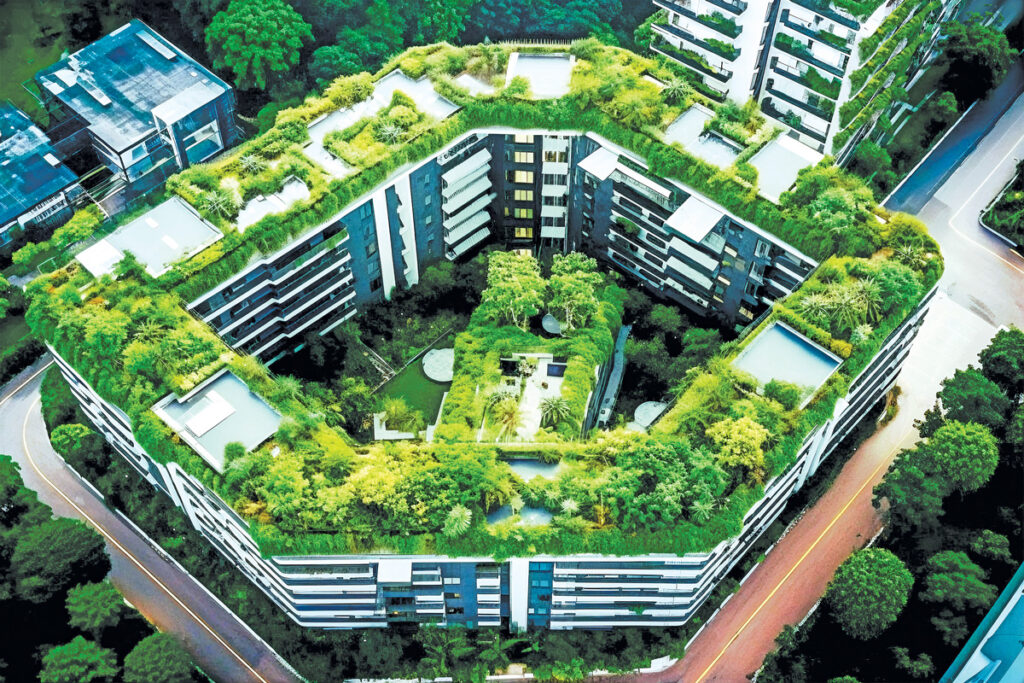GREEN-CERTIFIED REAL ESTATE IN INDIA CONTINUES TO RISE
Anshuman Magazine Chairman & CEO – India, South-East Asia, Middle East & Africa, CBRE India has embarked on a formidable mission to achieve net zero emissions by 2070, a pivotal announcement made at COP26. Moreover, at this year’s G20 Leadership Summit, India has placed a significant focus on energy and climate change mitigation initiatives as it pursues its goal, guided by the slogan ‘one earth, one family, one future’. Sustainability elements in

Anshuman Magazine
Chairman & CEO – India, South-East Asia, Middle East & Africa, CBRE
India has embarked on a formidable mission to achieve net zero emissions by 2070, a pivotal announcement made at COP26. Moreover, at this year’s G20 Leadership Summit, India has placed a significant focus on energy and climate change mitigation initiatives as it pursues its goal, guided by the slogan ‘one earth, one family, one future’. Sustainability elements in construction have emerged as a key priority since they define the competitiveness of any project. Sustainable building features and operations are increasingly becoming developers’ and occupiers’ most sought-after building attributes. The sector is now contributing towards the green goal and has set eyes on net-zero targets with intertwined decarbonisation strategies.

Presently, we are witnessing a heightened demand for green buildings as businesses recognise its criticality as we move towards building a sustainable economy. Companies are increasingly formulating strategies that consider these factors to ensure a sustainable and green future for the coming generations. With India’s considerable size and population, climate risks have multiplied, including the country among the top 10 most vulnerable nations. As per the Global Status Report for Buildings and Construction 2022, the sector accounted for over 34 per cent of energy demand and approximately 37 per cent of energy and process-related CO2 emissions in 2021, urging the integration of ESG into real estate and construction to drive sustainability objectives. As nations aim for net zero emissions, regulations for the real estate sector are anticipated to become more rigorous.
In 2022, India ranked second globally for Leadership in Energy and Environmental Design (LEED) green buildings with nearly 10.47 million gross area square meters (GSM) of space, trailing China. India awarded LEED certification to a total of 323 projects last year, an increase of more than twice the number of projects in 2021. India has consistently been placed within the top three countries in the list over the years, reflecting the growing adoption of LEED in the country as a means of curbing emissions, reducing environmental impact, and supporting the health and well-being of citizens.
As per the report ‘Indian Real Estate: Taking Giant Strides – 2023 Mid-Year Outlook’ by CBRE, green-certified office space in India has surged by over 36% since 2019, accounting for over 342 mn sq ft across the top six cities. Bangalore leads this trend with the highest green-compliant office stock, hosting 30% of India’s green office spaces. The city’s green office stock expanded by 26% from 2019 to reach 104.5 mn sq ft by June 2023. Bangalore, Delhi-NCR, and Mumbai collectively account for approximately 68% of India’s total, green-certified office stock as of June 2023, indicating substantial growth, expanding at a CAGR of around 7.1% over the past five years.
The adoption of renewable energy sources within buildings to fulfil energy requirements is advancing. Building designs are incorporating technologies including solar panels, wind turbines, and other renewable energy sources to utilise eco-friendly energy. However, their extensive implementation encounters hurdles associated with initial investment and infrastructure modifications. As technology progresses and costs decrease, we foresee a broader adoption of renewable energy sources in buildings.
Conventional construction methods are being upgraded to ensure a sustainable future, necessitating architects, engineers, and designers to adopt innovative technologies and principles that prioritise energy efficiency, resource preservation, and environmental responsibility. Sustainable features that are now part of upcoming projects include steel structures to hold solar panels, sewage treatment plants/water treatment plants, daytime light/ridge ventilation, greening of facilities, etc. A wide array of materials such as recycled materials, energy-efficient glass, eco-friendly wood, paints with low emissions, and advanced insulation materials are being integrated. Additionally, construction methods are emphasising the use of locally sourced and environmentally conscious materials to diminish the carbon footprint across the building’s entire lifespan. Innovative solutions are being adopted by developers, which include ensuring 100% sites have zero water discharge, aiming for 90% of their rental portfolio to be Green Building certified, reducing energy intensity, energy-efficient designs to lower energy consumption, eliminating on-site fossil fuel consumption, minimising waste-to-landfill footprint across their operations, using tech-enabled solutions for pollution monitoring, and upgrading to EV-ready infrastructure. Retrofitting existing properties to control pollution and waste is also critical to achieve a sustainable economy.
To accelerate sustainable construction and encourage increased development of eco-friendly buildings, collaborative initiatives are vital. This includes ongoing research into environmentally friendly materials, the advancement of energy-efficient technologies, promoting sustainable practices through incentives, and enforcing strict regulatory frameworks. Moreover, stakeholders in the industry—developers, architects, and policymakers—must join forces to prioritise sustainability, establish benchmarks, and foster an environment conducive to sustainable construction practices. A commitment to innovation, education, and policy reinforcement will play a crucial role in propelling the shift towards a more environmentally friendly and sustainable environment.







